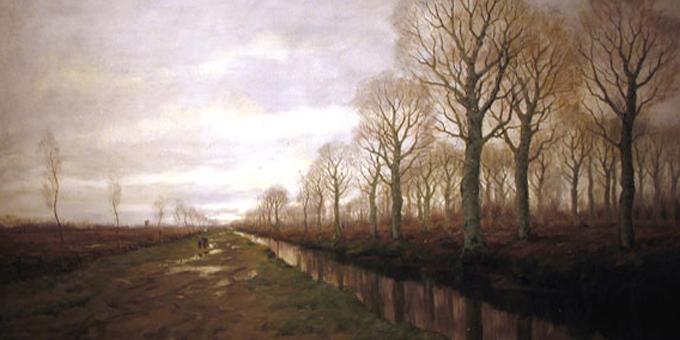Calvin hosts Hague School exhibition

The Center Art Gallery at Calvin College will be hosting “Between Nature and Nationality: The Hague School in the Nineteenth Century"
An opening reception and introductory lecture for the exhibition will take place from 7-9 p.m. on Saturday, Oct. 6.
The exhibition of over 25 paintings, prints and drawings is a significant collaboration among several Michigan institutions.
“Between Nature and Nationality” was drawn together from Calvin's permanent collection and from collections at The Detroit Institute of Art, the Grand Rapids Art Museum, The Holland Museum, the Muskegon Museum of Art, The Art Museum at Michigan State University, Hope College and two private donors.
“This is a great selection of works from Michigan collections,” said Calvin director of exhibitions Joel Zwart, a co-creator of the show, “and it's a great example of all of these institutions working together.”
Against idealization
The Hague School was an artistic movement of the late-19th century based on a group of Dutch artists who gathered around The Hague, a city in the Netherlands. The school was a move away from romantic idealization and toward Realism, said Zwart.
“It was related to the French Barbizon School,” he said, “where artists went outside to paint directly from nature as opposed to the intermediary step of taking the sketches from outdoors and bringing them inside to complete their work.”
The Hague School also has some relation to Impressionism.
“But unlike the French Impressionists,” said Zwart, “who wanted to capture the glory and brightness of light, the Dutch were preoccupied with gray and tonal variations. The art of the Hague School is very reflective of the Dutch landscape and the atmosphere.”
The realistic emphasis of the Hague School is in some ways a reaction to the Industrial Revolution that featured in the movement's historic backdrop, Zwart explained.
“Steamships and railroads were being developed, and there was an industrialization of society and the economy going on. So what these artists did was to go to The Hague and paint outside the city. They were capturing scenes of rural life: They captured peasants working out in the field, fisherman fishing in the sea, women washing their clothes.”
Through their subject matter and the nostalgia with which they invested it, the Hague School attempted to reflect a purer era.
“These artists thought they could get back to something basic and essential to life. They thought that this world was in need of purification or cleansing,” said Henry Luttikhuizen, a Calvin professor of art history and another of the show's organizers.
Assembling the exhibition
The art of the Hague School was popular with collectors during the late 20th century when “Holland-o-Mania,” a love of all things Dutch, was prevalent in U.S. culture.
“The main patrons for this art were wealthy businessmen from Scotland, England, Canada and the U.S.,” Zwart said.
The impetus for creating “Between Nature and Nationality” occurred when an alumnus of the college made known his intentions to donate a collection of paintings-many from The Hague School-to Calvin's permanent collection. This donation inspired Zwart and Luttikhuizen to assemble an exhibition of Hague School works.
“When you're putting together a show, you're dreaming about the works that will make it a great show,” Zwart said. “We were aware of a number of Hague School works throughout the state of Michigan, and we were interested in fulfilling a number of themes in the exhibition, and so we went to those individuals and institutions.”
Four Calvin faculty members have contributed essays to the exhibition catalogue, and the show has garnered support from a whole range of college departments.
The organizers of “Between Nature and Nationality,” hope that the exhibition also serves as a nice complement to “Modern and Contemporary Art from the Netherlands: the ABN AMRO Collection,” one of the debut exhibitions to be held at the new Grand Rapids Art Museum, opening Oct. 5.
“This show will be a good precursor to the works of those artists,” Zwart said.






